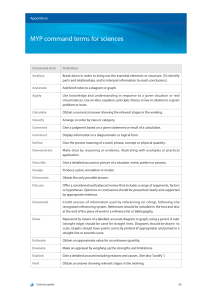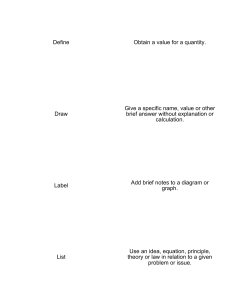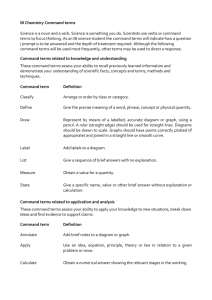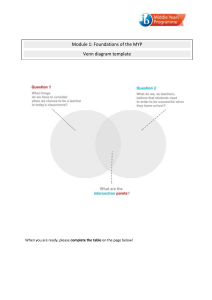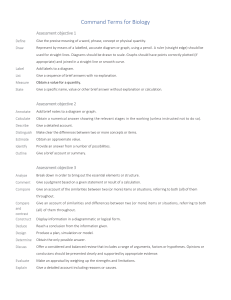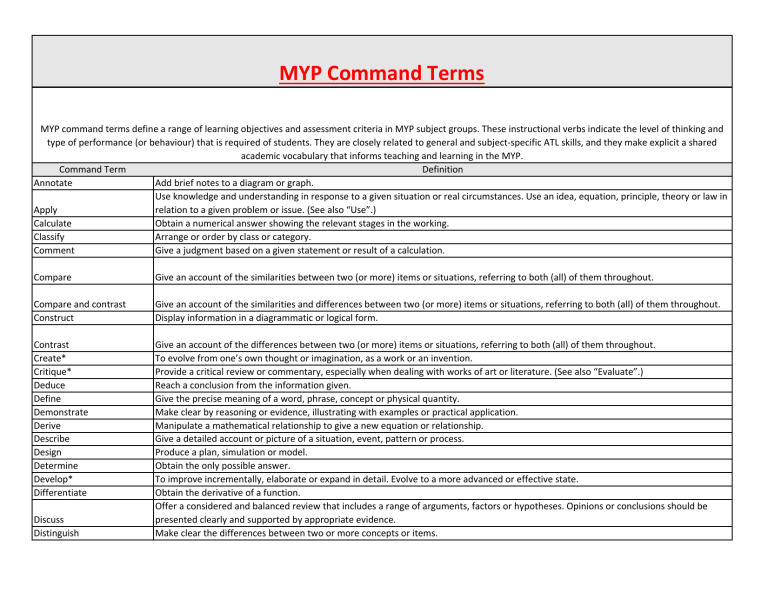
MYP Command Terms MYP command terms define a range of learning objectives and assessment criteria in MYP subject groups. These instructional verbs indicate the level of thinking and type of performance (or behaviour) that is required of students. They are closely related to general and subject-specific ATL skills, and they make explicit a shared academic vocabulary that informs teaching and learning in the MYP. Command Term Definition Add brief notes to a diagram or graph. Annotate Use knowledge and understanding in response to a given situation or real circumstances. Use an idea, equation, principle, theory or law in Apply relation to a given problem or issue. (See also “Use”.) Obtain a numerical answer showing the relevant stages in the working. Calculate Arrange or order by class or category. Classify Give a judgment based on a given statement or result of a calculation. Comment Compare Give an account of the similarities between two (or more) items or situations, referring to both (all) of them throughout. Compare and contrast Construct Give an account of the similarities and differences between two (or more) items or situations, referring to both (all) of them throughout. Display information in a diagrammatic or logical form. Contrast Create* Critique* Deduce Define Demonstrate Derive Describe Design Determine Develop* Differentiate Give an account of the differences between two (or more) items or situations, referring to both (all) of them throughout. To evolve from one’s own thought or imagination, as a work or an invention. Provide a critical review or commentary, especially when dealing with works of art or literature. (See also “Evaluate”.) Reach a conclusion from the information given. Give the precise meaning of a word, phrase, concept or physical quantity. Make clear by reasoning or evidence, illustrating with examples or practical application. Manipulate a mathematical relationship to give a new equation or relationship. Give a detailed account or picture of a situation, event, pattern or process. Produce a plan, simulation or model. Obtain the only possible answer. To improve incrementally, elaborate or expand in detail. Evolve to a more advanced or effective state. Obtain the derivative of a function. Offer a considered and balanced review that includes a range of arguments, factors or hypotheses. Opinions or conclusions should be presented clearly and supported by appropriate evidence. Make clear the differences between two or more concepts or items. Discuss Distinguish Document* Draw Estimate Evaluate Examine Explain Explore Find Formulate Hence Otherwise Identify Integrate Interpret Investigate Justify Label List Measure Organize* Outline Plot Predict Present Prioritize* Prove Select* Show Show that Sketch Solve State Suggest Credit sources of information used by referencing (or citing) following a recognized referencing system. References should be included in the text and also at the end of the piece of work in a reference list or bibliography. Represent by means of a labelled, accurate diagram or graph, using a pencil. A ruler (straight edge) should be used for straight lines. Diagrams should be drawn to scale. Graphs should have points correctly plotted (if appropriate) and joined in a straight line or smooth curve. Obtain an approximate value for an unknown quantity. Make an appraisal by weighing up the strengths and limitations. (See also “Critique”.) Consider an argument or concept in a way that uncovers the assumptions and interrelationships of the issue. Give a detailed account including reasons or causes. (See also “Justify”.) Undertake a systematic process of discovery. Obtain an answer showing relevant stages in the working. Express precisely and systematically the relevant concept(s) or argument(s). Use the preceding work to obtain the required result. It is suggested that the preceding work is used, but other methods could also receive credit. Provide an answer from a number of possibilities. Recognize and state briefly a distinguishing fact or feature. Obtain the integral of a function. Use knowledge and understanding to recognize trends and draw conclusions from given information. Observe, study, or make a detailed and systematic examination, in order to establish facts and reach new conclusions. Give valid reasons or evidence to support an answer or conclusion. (See also “Explain”.) Add a title, labels or brief explanation(s) to a diagram or graph. Give a sequence of brief answers with no explanation. Obtain a value for a quantity. Put ideas and information into a proper or systematic order. Give a brief account or summary. Mark the position of points on a diagram. Give an expected result of an upcoming action or event. Offer for display, observation, examination or consideration. Give relative importance to, or put in an order of preference. Use a sequence of logical steps to obtain the required result in a formal way. Choose from a list or group. Give the steps in a calculation or derivation. Obtain the required result (possibly using information given) without the formality of proof. “Show that” questions do not generally require the use of a calculator. Represent by means of a diagram or graph (labelled as appropriate). The sketch should give a general idea of the required shape or relationship, and should include relevant features. Obtain the answer(s) using algebraic and/or numerical and/or graphical methods. Give a specific name, value or other brief answer without explanation or calculation. Propose a solution, hypothesis or other possible answer. Summarize* Synthesize* To what extent Trace Use Verify Abstract a general theme or major point(s). Combine different ideas in order to create new understanding. Consider the merits or otherwise of an argument or concept. Opinions and conclusions should be presented clearly and supported with appropriate evidence and sound argument. Follow and record the action of an algorithm. Apply knowledge or rules to put theory into practice. (See also “Apply”.) Provide evidence that validates the result. Write down Obtain the answer(s), usually by extracting information. Little or no calculation is required. Working does not need to be shown.
